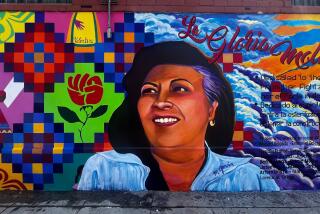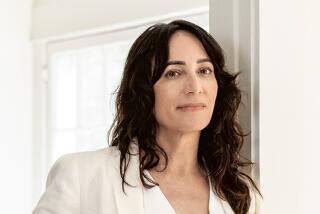Critic’s Notebook: Karen Finley slips into the skin of other women
In “The Jackie Look,” the last of eight monologues that make up her new book “The Reality Shows” (Feminist Press: 256 pp., $17.95 paper), Karen Finley offers a statement that suggests her point of view. “Life,” she writes, “is more important than art / But life is meaningless without art.” Finley may be speaking in the voice of Jackie Kennedy, but she is also referring to herself. In the generation since she, along with fellow performance artists John Fleck, Tim Miller and Holly Hughes, were stripped of federal grant funding as members of the NEA Four, Finley has found herself represented in ways she never imagined, turned into a mirror for those on both sides of the free expression divide.
“At one point,” she says in her office at New York University, where she is a professor in the Tisch School’s department of art and public policy, “I came to a realization that I felt like I had been in an abusive relationship with Jesse Helms.” (Helms was the National Endowment for the Arts’ chief opponentin the Senate.) She gives a low laugh, as if a bit wary of the image. “I actually lost my sense of humor for a little bit, which is the most dangerous place to go.”
Finley is 55, casual and confident, speaking with a quiet Midwestern twang. She still works in a variety of mediums: print, stage and visual art. “The Reality Shows” reflects this, featuring not only text but also drawings, watercolors and performance photos, as well as a timeline that begins with Wikipedia going online in January 2001. At the same time, it is a deeply “written” project, intended for the page as much as the stage. “I’m much more of a studied writer than I am a studied performer,” Finley acknowledges. “That’s why many times I read my performance, to establish a relationship to the writing.”
If “The Reality Shows” grew out of Finley’s troubles in the 1990s, it also reflects our collective troubles in the decade after that. It is a collection of public stories, or, as Finley calls them, “national narratives” — although each is personal in the most fundamental sense. The characters are Liza Minnelli, Laura Bush, Martha Stewart, Terri Schiavo, Silda Spitzer: women who, like Finley, have become important not so much for who they are as for what they represent. “I started thinking about certain national narratives with the second George being voted into office,” Finley notes. “I think we voted in a story about his relationship with his father. Is it the only narrative? No. Is it a little analytical, academic? Yeah. But it’s a way of looking at how people select relationships, or interact with power.”
Such a tension — between the real story and the meta-story, between what we see and what it means — has long been at the core of Finley’s art. In the 1980s, she became known for exploring the objectification of women in performance pieces that turned objectification on its ear. Finley appeared naked, smeared herself with chocolate. She spoke out about sexuality and rape. The subtext was violence, but equally important was the question of complicity. “In the 1970s and 1980s,” she recalls, “women artists were marginalized to a greater extent than they are now. So I made a conscious decision that if the female is being objectified then I was going to objectify myself. When I was speaking, I was speaking as a voice of all women. The events in my pieces didn’t necessarily happen to me, but as a writer, who is the I, the first person? Who does the artist represent?”
Similar questions motivate “The Reality Shows.” If the narratives have shifted — from the internal to the external — it’s a reaction to Finley’s own notoriety. “I found I was participating in the drama,” she says of her NEA Four experience, “and I no longer wanted to do that.” Even so, Finley insists, the problem wasn’t only politics; there were other issues, most essentially “that my femaleness, that character, was victimized and I no longer wanted to be victimized. Nor did I want to be the hero. I had become an archetype with my public persona.”
Here we see the challenge of the artist who goes public, since the border between life and work can’t help but blur. It can happen in any medium — memoir, film, photography — but none so directly as performance, where the artist becomes, in a very real sense, what she creates. This all came to a head after Sept. 11, 2001, when Finley began to develop a performance about the tragedy of the towers’ fall. “For some reason,” she says, “I felt that I was not connecting to the audience. … And I realized that there was an expectation of who Karen Finley was, as if I were speaking in my own voice. I started thinking about how in therapy for children they have transference objects. And I thought, well, Liza Minnelli represents New York. That’s why I started using public figures and speaking through them, and using the intimacy of national narratives and how society becomes so engulfed with certain stories or people.”
What this reveals is the intentionality behind Finley’s performances, which often gets overlooked. Still, if that suggests a certain irony, it’s just one of many responses her work provokes. She is herself a public figure, now writing about public figures, using them to trace a private narrative. She is both a victim of the image culture and a beneficiary, using our fascinations to look at our collective inner lives. “I think in archetypes,” she says, “and I became fascinated with the phenomenon of people being interested in a person they haven’t met. Maybe because there is no national narrative for everyone, American society or the media will focus or become almost addicted toward these kinds of individuals.”
More to Read
Sign up for our Book Club newsletter
Get the latest news, events and more from the Los Angeles Times Book Club, and help us get L.A. reading and talking.
You may occasionally receive promotional content from the Los Angeles Times.







